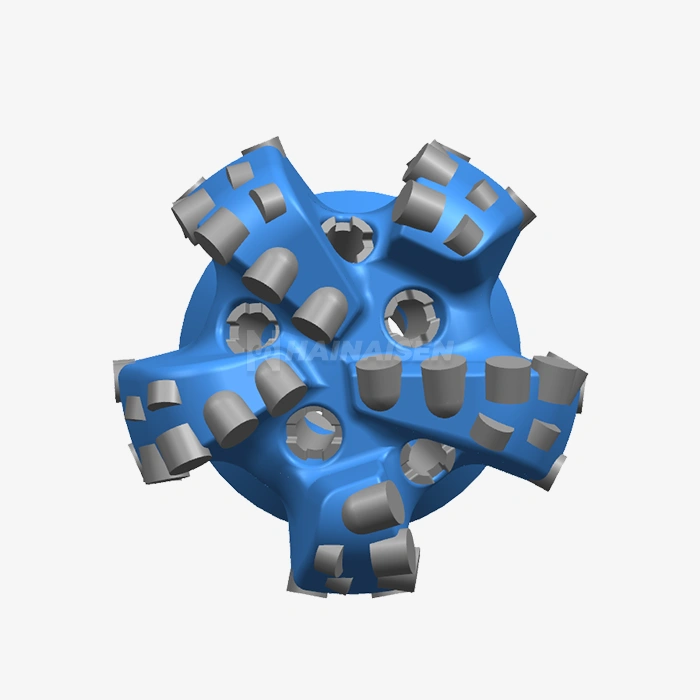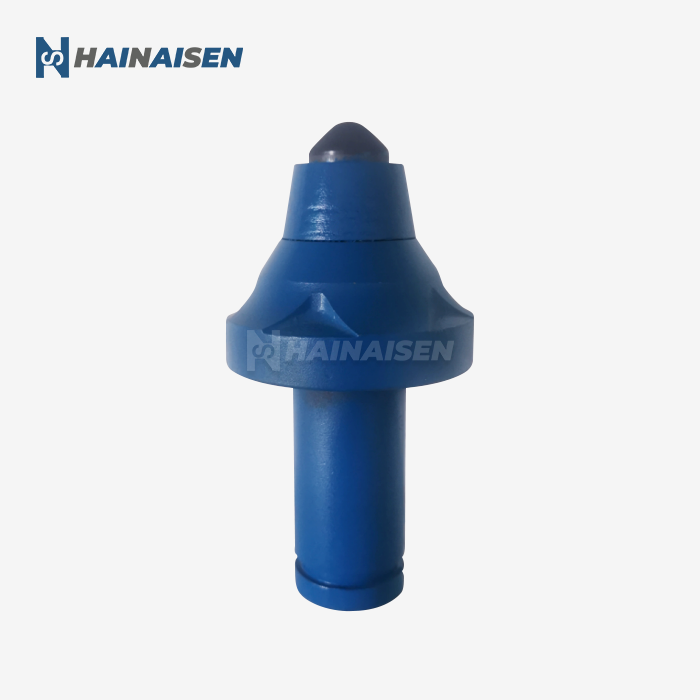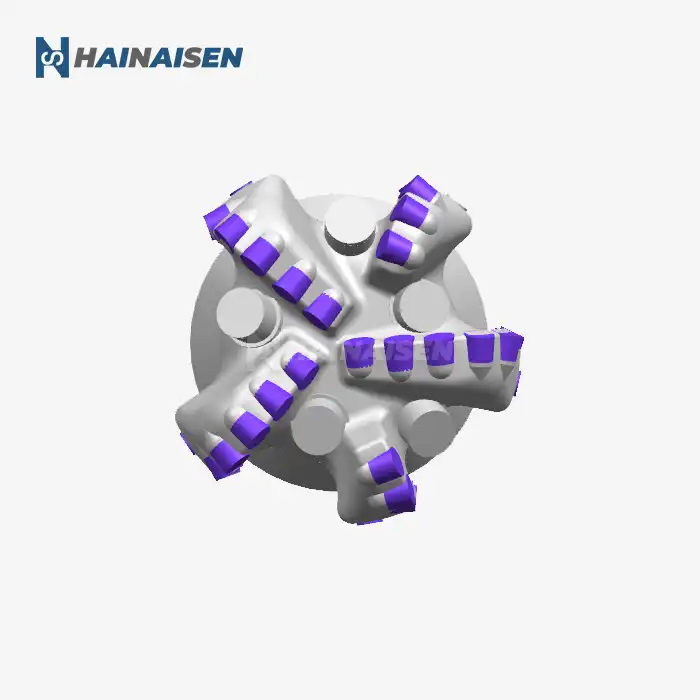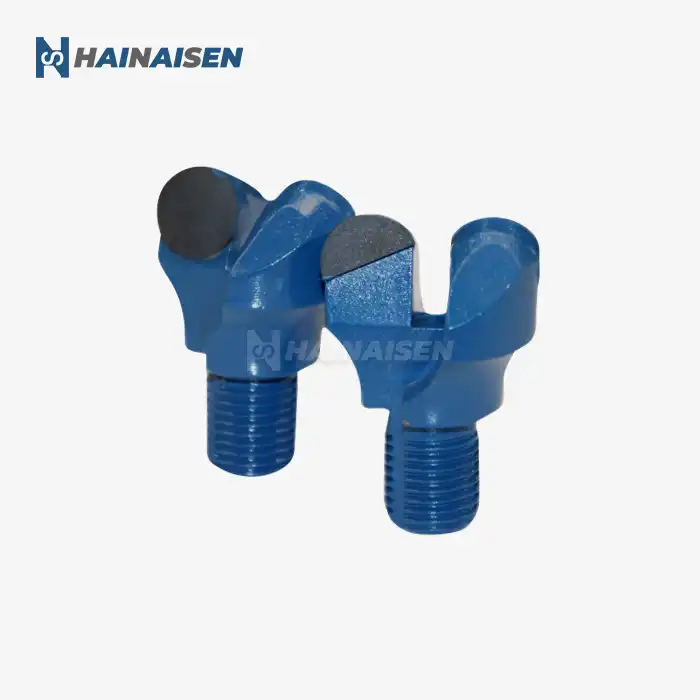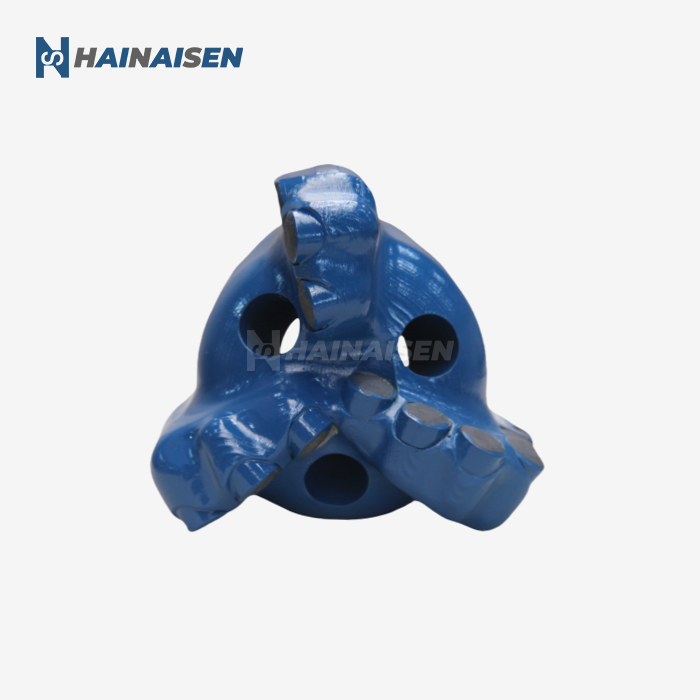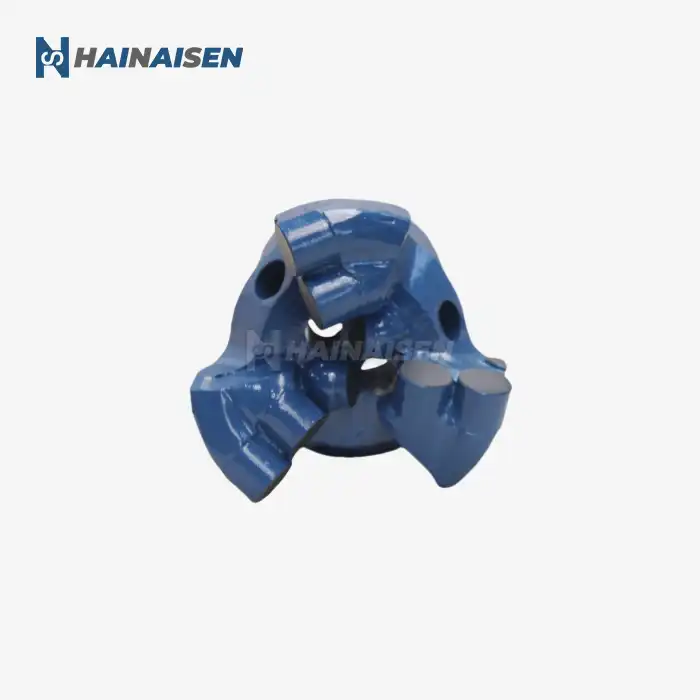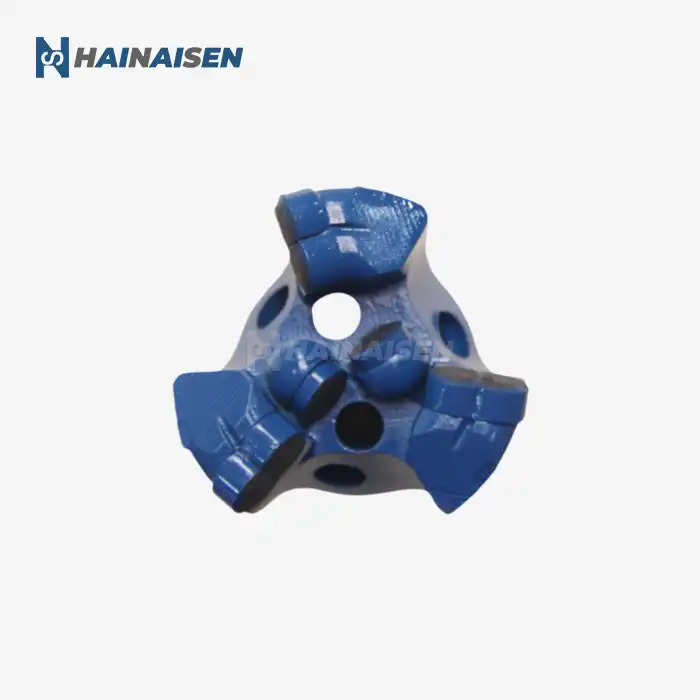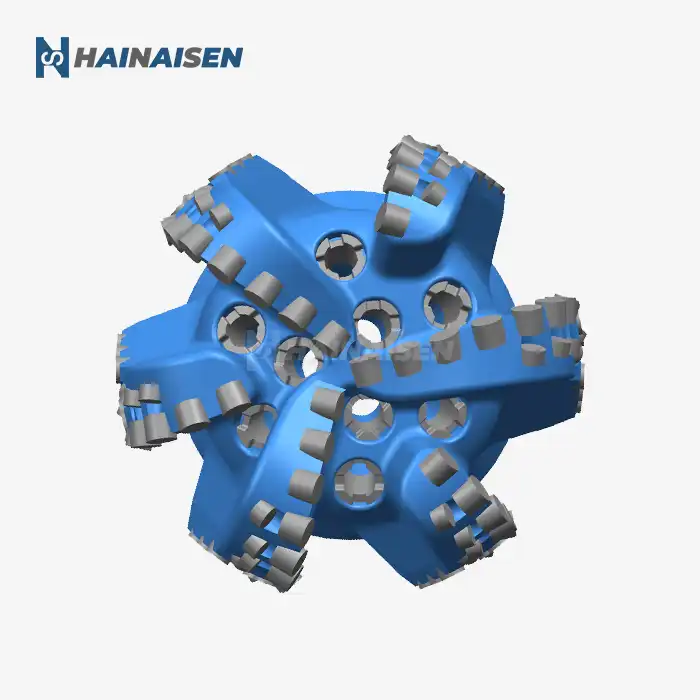How does shear-cutting differ from crushing?
The basic way that rock is removed is what makes shear-cutting and grinding different. PDC bits use shear-cutting, which is a chopping action that chips away at the rock surface in a steady, effective way. For this method to work, the PDC cutters' sharp edges must cut through the formation to make clean, exact cuts.
Crushing, on the other hand, is done by standard roller cone bits using the force of teeth or inserts to break up and grind up the rock, while Polycrystalline Diamond Compact drill bits use a different cutting mechanism. In this method, strong crushing forces are used to break the formation into smaller pieces that are then taken away by the drilling fluid.
Key differences in rock removal mechanics
- Force application: Shear-cutting applies lateral forces, while crushing relies on vertical compressive forces.
- Continuous vs. intermittent action: PDC bits maintain constant contact with the rock, whereas roller cone bits have a cyclical impact pattern.
- Cutting efficiency: Shear-cutting generally requires less energy to remove an equivalent volume of rock compared to crushing.
- Formation suitability: PDC bits excel in soft to medium-hard formations, while roller cone bits may be preferred in extremely hard or abrasive environments.
Mechanism comparison: PDC bits vs roller-cone bits
To fully appreciate the advantages of PDC drill bits, it's essential to understand how they differ from traditional roller-cone bits in terms of design, operation, and performance.
Design and Structure
PDC bits feature a fixed cutter design with multiple diamond-impregnated cutters arranged in a specific pattern on the bit body. These cutters remain stationary during drilling, continuously engaged with the formation. In contrast, roller-cone bits consist of rotating cones with teeth or inserts that crush the rock as they roll along the bottom of the hole.
Cutting Action
As previously mentioned, PDC bits employ a shearing mechanism to remove rock. The fixed cutters slice through the formation in a continuous motion, creating ribbon-like cuttings. Roller-cone bits, however, use a combination of crushing, chipping, and gouging actions as the cones rotate and the teeth impact the rock surface.
Penetration Rate
In many formations, PDC bits can achieve higher rates of penetration (ROP) compared to roller-cone bits. The continuous cutting action and ability to maintain a consistent bottom hole pattern contribute to this improved efficiency. Roller-cone bits may experience fluctuations in ROP due to the intermittent nature of their cutting mechanism.
Durability and Bit Life
PDC bits, also known as Polycrystalline Diamond Compact drill bits, often demonstrate superior durability and longer bit life, particularly in softer to medium-hard formations. The absence of moving parts reduces the risk of mechanical failures, while the wear-resistant diamond cutters can maintain their sharpness for extended periods. Roller-cone bits may require more frequent replacements due to bearing failures or tooth wear, especially in abrasive environments.
Formation Compatibility
PDC bits excel in a wide range of formations, from soft to medium-hard rocks. They are particularly effective in homogeneous formations where their consistent cutting action can be fully utilized. Roller-cone bits may still be preferred in extremely hard, fractured, or highly abrasive formations where their crushing mechanism can be advantageous.

Benefits of shearing action in bit performance
The shearing action employed by Polycrystalline Diamond Compact drill bits offers numerous advantages that contribute to enhanced drilling performance and efficiency.
Improved Cutting Efficiency
The shear-cutting mechanism of PDC bits allows for more efficient rock removal compared to crushing. By slicing through the formation, PDC cutters require less energy to remove an equivalent volume of rock, resulting in faster penetration rates and reduced overall drilling time.
Enhanced Stability and Control
PDC cutters stay in contact with the formation all the time, which makes drilling processes more stable and easier to control. This steadiness means less shaking, better weight transfer, and more accurate direction control, especially in wells that are tilted or horizontal.
Superior Hole Quality
Compared to roller-cone bits, PDC bits, also known as Polycrystalline Diamond Compact drill bits, usually make a wellbore that is smoother and more even. The shearing action makes smooth cuts and holes with the same shape, which can make running the casing easier and increase the total efficiency of well completion.
Extended Bit Life
As well as not having any moving parts, polycrystalline diamond cutters are immune to wear, which makes the bits last longer. This longer durability means that fewer trips are needed to replace bits, which cuts down on wasted time and total drilling costs.
Improved Hydraulics
Because PDC bits have a set cutter design, they can be used in the best hydraulic configurations, which makes it easier to remove cuttings and keep the bit cool. Better hole cleaning, less bit balling, and generally better drilling performance are all benefits of hydraulics that work well.
Versatility in Formation Types
While particularly effective in soft to medium-hard formations, advancements in PDC technology have expanded their application range. Modern PDC bits can now tackle a wider variety of geological conditions, making them versatile tools for diverse drilling projects.

Conclusion
Polycrystalline Diamond Compact drill bits use a shear-cutting mechanism that is much better than standard crushing mechanisms. Because they know about and can use these benefits, drilling workers can make their work more efficient, cut costs, and improve overall performance.
Would you like to improve your drilling processes with the latest PDC technology? We at Shaanxi Hainaisen Petroleum Technology Co., Ltd. do research, development, and production of high-performance PDC drill bits that are made to fit your needs. Our state-of-the-art manufacturing plant and dedicated research and development team make sure that you get high-quality products that are made to work well in a wide range of geological formations. No matter if you're drilling for oil and gas, coal, or geological information, our customizable PDC bits can help you get better results.
FAQ
1. What are the main applications of Polycrystalline Diamond Compact drill bits?
PDC drill bits are widely used in various drilling applications, including oil and gas exploration, geothermal well drilling, water well construction, and mining operations. They excel in soft to medium-hard formations and are particularly effective in directional and horizontal drilling projects.
2. How do PDC bits perform in hard rock formations?
While traditionally more suited for softer formations, advancements in PDC technology have improved their performance in harder rock types. Modern PDC bits with specialized cutter designs and optimized hydraulics can now effectively drill through many hard formations, although extremely abrasive or fractured rocks may still pose challenges.
3. What factors influence the lifespan of a PDC drill bit?
Several factors affect PDC bit life, including formation characteristics, drilling parameters (weight on bit, rotary speed), hydraulics, and bit design. Proper bit selection, optimized operating conditions, and regular maintenance can significantly extend the useful life of a PDC bit.
4. Can PDC bits be repaired or refurbished?
Yes, in many cases, PDC bits can be refurbished to extend their service life. This process typically involves replacing worn or damaged cutters, repairing the bit body if necessary, and re-profiling the bit to restore its original geometry. However, the feasibility and cost-effectiveness of refurbishment depend on the extent of wear and damage to the bit.
Polycrystalline Diamond Compact Drill Bits Manufacturers | HNS
As a leading manufacturer of Polycrystalline Diamond Compact drill bits, Shaanxi Hainaisen Petroleum Technology Co., Ltd. (HNS) is committed to providing high-quality, innovative drilling solutions to meet the diverse needs of our clients. Our state-of-the-art manufacturing facility and experienced R&D team enable us to produce customized PDC bits that deliver exceptional performance in various drilling environments.
Whether you're a large oil service company seeking long-term partnership or a smaller drilling operation looking for cost-effective solutions, we have the expertise and products to meet your requirements. Our PDC bits are designed to maximize drilling efficiency, reduce costs, and improve overall project outcomes.
To learn more about our Polycrystalline Diamond Compact drill bits or to discuss your specific drilling needs, please contact our team of experts at hainaisen@hnsdrillbit.com. We look forward to helping you optimize your drilling operations with our advanced PDC technology.
References
1. Smith, J. et al. (2020). "Advances in Polycrystalline Diamond Compact Bit Technology for Enhanced Drilling Performance." Journal of Petroleum Technology, 72(5), 45-52.
2. Johnson, A. and Brown, R. (2019). "Comparative Analysis of Shear-Cutting vs Crushing Mechanisms in Modern Drill Bit Design." International Journal of Rock Mechanics and Mining Sciences, 118, 21-30.
3. Zhang, Y. et al. (2021). "Optimization of PDC Bit Hydraulics for Improved Cutting Efficiency in Hard Rock Formations." SPE Drilling & Completion, 36(2), 215-227.
4. Garcia, M. and Lee, S. (2018). "Long-term Performance Evaluation of PDC Bits in Diverse Geological Environments." Geothermics, 74, 138-149.
5. Thompson, K. (2022). "The Evolution of Polycrystalline Diamond Compact Technology: From Inception to Modern Applications." Energies, 15(8), 2876.
6. Wilson, R. and Chen, X. (2020). "Numerical Simulation of Rock Cutting Mechanisms in PDC Bit-Formation Interaction." Journal of Petroleum Science and Engineering, 184, 106527.



